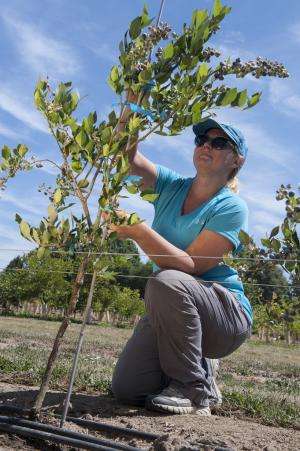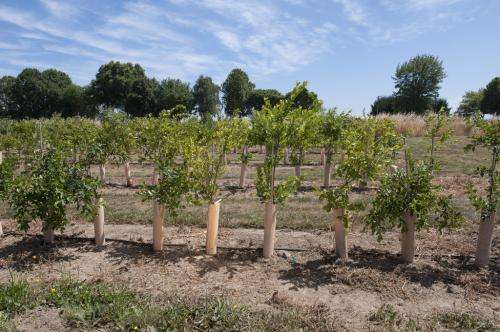Single-stem blueberry "tree" may lower production costs

An Oregon State University researcher aims to lower production costs for growers by creating a new kind of blueberry that develops as a tree instead of the traditional bush.
Wei Qiang Yang, blueberry agent for the Oregon State University Extension Service, has tested a grafted blueberry "tree" that grows on a single stem on a research plot at OSU's North Willamette Research and Extension Center in Aurora every year since 2009. Yang is collaborating with researchers who are testing other blueberry varieties grafted onto rootstocks at land-grant universities in California and Florida as part of a multi-state effort.
"The first rootstock that will come out of this research for commercial use will significantly change the way blueberries are currently produced and harvested," said Yang, a horticulture professor in OSU's College of Agricultural Sciences.
The research could benefit an industry that's economically important to Oregon. The blueberry industry contributed $107.5 million in sales to Oregon's economy in 2012, according to a report by the United States Department of Agriculture and OSU Extension. Growers produced 72 million pounds of blueberries on nearly 8,000 acres.
Growers use machine harvesters with catch plates to collect blueberries, but because blueberry bushes have multiple stems, the catch plate cannot fully encircle each stem of the bush. So growers must bear about a 15-25 percent loss in terms of the fruit that the catch plate misses, according to Yang. But cultivating a blueberry bush in a tree form would change that, he said.
"This work isn't just academically important, but it's valuable from a practical standpoint in that it will be very significant for improving machine harvesting efficiency and the adaptability of blueberry plants to different soil conditions," Yang said. "The wild-grown species is better-adapted to nutrient-poor and relatively high-pH soil. If we're successful, this is going to change the way we raise blueberries."

To make the grafts, Yang started with seeds from a wild-growing blueberry plant commonly known as sparkleberry, which originated in Texas, Oklahoma and Florida. In the wild, some plants grow on a single stem to heights of up to 10 feet. But their tiny berries are full of seeds and the fruit has a bad taste, Yang said. He then grafted three popular highbush blueberry varieties – Liberty, Aurora and Draper – onto the wild-growing plants. He wanted a blueberry plant that had a similar yield to its domestic cousins and had a good taste.
So far, yields of the grafted plants have compared favorably to their domesticated cousins, with the exception of Liberty. A grafted Liberty plant yielded an average of approximately 1.03 pounds of fruit per single tree, compared to an average of 1.68 pounds per single bush on a domesticated Liberty plant. A grafted Draper plant yielded an average of approximately 0.60 pounds of fruit per single tree, while a domesticated Draper plant yields an average of 0.55 pounds per single bush. A grafted Aurora yielded an average of 1.07 pounds of fruit per single tree, while a domesticated Aurora yields an average of 0.88 pounds of fruit per single bush. Taste has also compared well.
Yang must still analyze results of data collected on fruit quality factors such as firmness, size and total acidity. This is the first year researchers were able to collect data on yield for the project in Oregon. Yang will investigate future yield projections and machine harvesting potential next. If results continue to show promise, the blueberry tree could be ready for release to nurseries in approximately five years for commercial use and about three years for gardeners.
Though some people have tried grafting blueberry trees on a small-scale basis in the past, Yang said this is the first major collaborative research effort to graft a blueberry tree that is viable for commercial growers.
Provided by Oregon State University


















